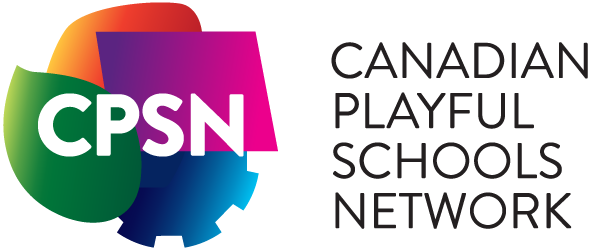I (Gladys) had the pleasure of meeting virtually with David McFall, the principal of Pierre Elliott Trudeau Elementary school in Gatineau, QC. PETES is experienced in play-based innovation and has found ways to bring in their community and incorporate outdoors and play into their pedagogy. David and I sat down to chat about how his school got to this place, and why he and his teachers do this work. The full interview (45 minutes) and an abridge version of it is available below.
How have you brought community involvement into your school?
David: English schools in this part of Quebec have to do more because we don’t have community around us. We have to actively build it. For example, for Autism Awareness day, we had a huge community event on a Sunday with guest speakers, prizes and food, and did a walk through the neighbourhood. That brought out 15-20 staff members on a Sunday and over 150 community members. Once you start having activities, it brings up other ideas like “we can do this”. It makes people want to do something different, and fun!
There are a lot of moving parts to organizing events and implementing new activities and regimes, how do you manage?
David: It doesn’t happen overnight (laugh). When I think about it, it’s nothing massive, it’s a lot of little things. It starts with just having your eyes open to seeing new possibilities and new opportunities. It’s as simple as having weekly parent meetings to connect with parents on a weekly basis and let them know what events are happening or what decisions are being made at the school. Sometimes parents agree or they don’t agree, but when you have the dialogue, it allows parents to get a different perspective and you can build those relationships. Then, they become your allies. So when you have difficult decision to make, parents are more understanding and supportive. Also, there’s exchange of ideas – a parent would say something and I’d go “I never thought about that” or I’ll say something and somebody else will have another idea. So just giving the opportunity for the exchange of ideas. The more you can do that with teachers, parents, community members, I feel the health of the school – the way you see school – is going to change or improve.
What about staff hesitancy? How do you approach that?
David: That’s a difficult one to keep your finger on the pulse with the staff. COVID is a good example of that, everyone was doing twice as much to keep up with the changing protocols and still having to teach. It was pushing, pushing, pushing. And when teachers came back this year, they were still exhausted. Inevitable gaps of learning had taken place over the 2.5 years of COVID and the evaluation framework was still the same. Teachers came back and realized they still have to evaluate a student at the same grade and same time as previous years, yet the gaps were there. They got stressed because they realized the marks on report cards were going to be a little bit lower, because it’s inevitable. So, you have to just know when to just back off and let teachers breathe and push through something that was quite frankly was a bit unfair to them.
Your CPSN project is a “Genius Hour” where students self-select and engage in an activity of interest. Can you tell us more about your project?
David: The project is almost like a Seinfeld episode where you think on the surface “It’s all about nothing” because the teachers aren’t in control of it. The students are. Every second Friday afternoon regular classes are blocked off in 5 different classrooms and students go and work on their own projects. It could be robotics, something to do with music, creating different games. Then we’re building towards a huge end-of-year afternoon or day where the whole school and community will come and see what the students have been working on.
How is the project is impacting your students?
David: I’m telling you, something’s changed. Imagine a regular Friday afternoon where kids are low energy and we’re trying to push through that last math concept or let’s look at another stanza in a poem and it’s done from a teacher-directed way. You won’t get the same level of engagement. But you should just see how excited the students are on Friday afternoons. It’s about learning the soft skills: collaboration, leadership, following instructions, taking the lead from one another. One of the remarks the teachers have made is that they’re taking the projects home, talking to their parents about it, and working online with one another.
Some may think that if children are allowed complete independence in an activity, they would “muck about” and not necessarily try to work towards anything. How would you respond to criticism like that?
David: Teachers find that really scary. That “letting go” part, I find, is the biggest leap. And once they take that leap and they trust and leave it and see the benefits, they go “this is beautiful” it’s those eyes being open to something they were never open to before not being in charge. Students are brilliant when they get the chance to be in the lead. You obviously have to set up parameters. It’s very methodical. You set them up for success and draw them in by having this freedom.
Can you speak more about these parameters?
David: There’s not like a formula. Teachers need to skillfully and strategically bind and prompt wild ideas into things that are more possible and manageable in an afternoon. It’s nudging kids they know have similar interests and saying like “you both love this thing” or “have this shared interest”. Some kids didn’t have any interests and had no excitement within them. It’s finding that excitement and giving them a little group to join so that every kid is included. It’s taking the ridiculously big ideas and bringing them down into something the teachers find workable within the class – something they can make or showcase at the end of the year. I’m also lucky that the teachers involved really know their kids.
What drives you to do this with your school?
David: Because school’s supposed to be fun! Something’s changed in society in the last 10 or so years, probably longer, where the amount of play and the amount of time spent outdoors for children and adults has decreased significantly. When kids aren’t outdoors in play, when they’re not in nature, their development is not unfolding the way it’s supposed to. All those skills that kids were supposed to acquire were through play (figuring things out, building resiliency, building fairness when picking teams, tears, compassion), all of that plays out in real and metaphorical playgrounds. So, when that isn’t happening, the schools see that. We noticed it with kindergartners coming in, being 5-year-old but not emotionally being 5 and having a really difficult time in the four walls of the class. We took them outside, let them get what their development requires. We did this because we had to. Because if we didn’t the kids wouldn’t reach their full potential the way they’re supposed to. I feel there’s a responsibility to be placed on all schools to notice this and close these gaps. Not every kid is coming to school with a backpack full of basic love, attention, attachment, healthy relationships and multiple caring adults in their lives. So the school has to do something different so that all kids have a good chance. If they don’t have those emotional needs fulfilled they cannot focus on their learning because they’re in pursuit of that emotional need.

Gladys Ayson is a PhD candidate in the Experimental Psychology program at the University of Ottawa. Her research focuses on children’s cognitive development, specifically their developing understanding of the future. She also works for a non-profit organization that tutors new Canadian children on their English and financial literacy. Her passions include supporting new Canadian families, translating children’s research into accessible knowledge for families, and stemming change in the Canadian education system.
